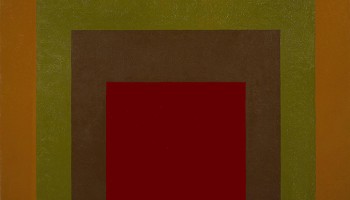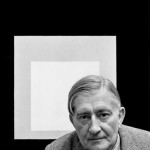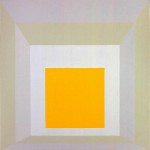Josef Albers

Albers was born in Bottrop, Germany on March 19, 1888. He studied art in Berlin, Essen, and Munich, before enrolling at the famous Bauhaus-Weimar school in 1920. It was there that the Walter Gropius, the founder of the Bauhaus asked him to teach the course ‘Werklehhre’ that was uses as an introduction to the principles of handicrafts in to new students in 1923. He was promoted to Professor in 1925, the same year the school moved to Dessau. At Dessau he taught with famed artists/instructors Oskar Schlemmer, Wassily Kandinsky and Paul Klee. 1925 was also the year that Albers married fellow student Anni Albers.
Click here to continue reading this biography
Bauhaus was forced to close its doors in 1933 due to consistent pressure from the Nazi’s who referred to their style as degenerate and called the school a front for communism. It was then that Albers emigrated to America. Upon his arrival to the United States, Albers joined the teaching staff at Black Mountain College in North Carolina where he would run the painting department until 1949. His students included such notable artists as Cy Twombly, Robert Rauschenberg, Ray Johnson and Susan Weil. Susan Weil later said that as an instructor, Albers was “his own academy” and that Albers told his students that “when you’re in school, you’re not an artist, you’re a student”,
Albers left Black Mountain College teach at Yale in1949. He managed the Department of Design until his retirement from teaching in 1958. Some of his notable students at Yale included Richard Anuszkiewicz and Eva Hesse. He continued to design, paint and write and in 1973 was elected as a Fellow of the American Academy of Arts and Sciences. Albers continued to live and work in New Haven with Anni, his wife of more than 50 years, until his death on March 25, 1976.
Although he was an accomplished photographer, designer, poet, graphic artist and theorist, Albers will always be remembered most for his work as an abstract artist. Among his most well known works are the hundreds of paintings and prints that pay homage to the square. Begun in 1949, they explore the interactions of solid colored squares placed inside one another.
Although rooted in European Bauhaus, his work would have a tremendous impact on American artists working in the late 50’s and early 60’s.
- Portrait of Josef Albers
- On Tideland – 1947-1955
- Variant (Orange Front) – 1948–58
- Homage to the Square: Gained – 1959
- Variant VII – 1966
- Homage to the Square (Insert) – 1976
- Homage to the Square RIII – 1970
- D – 1976








